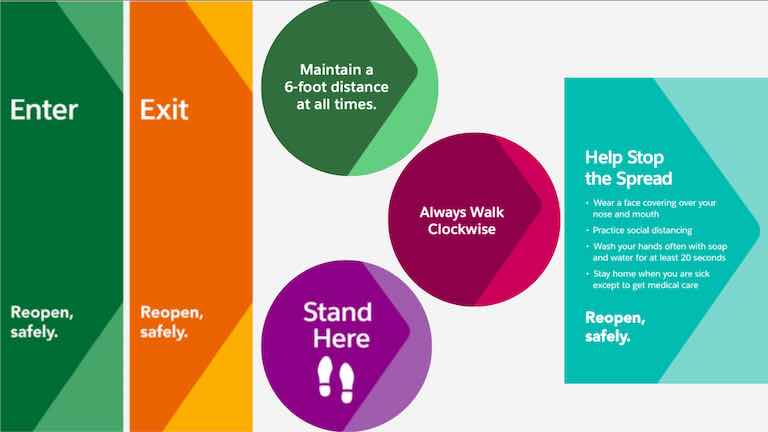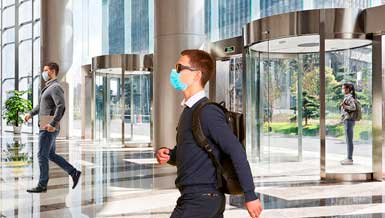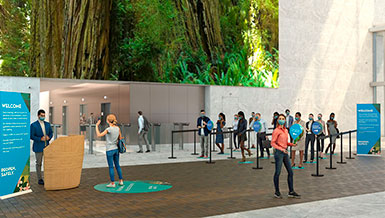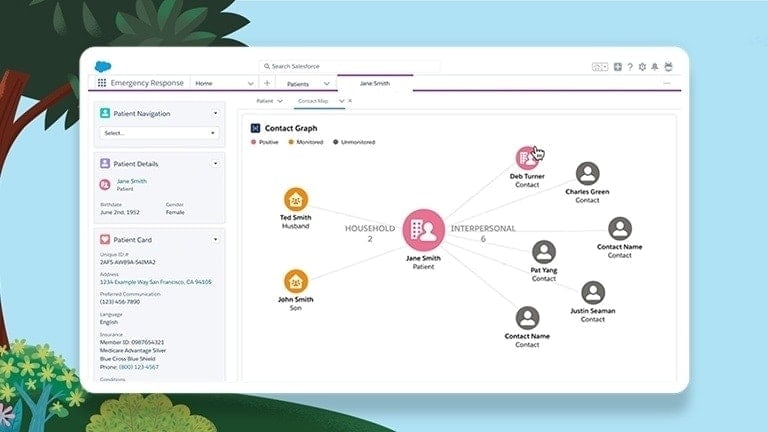Chapter 2: How to Create A Return-To-Work Plan
Executive Vice President of Global Real Estate, Salesforce
The task of reopening your business after months of closure can be daunting. So much has changed. You’ve worked with your leadership team to develop a V2MOM for reopening offices. You’ve defined the criteria to reopen that make sense for your business. You’ve done the strategic legwork. Now, it’s time to get down to brass tacks.
Enter: your return-to-work plan.
It will help detail your approach to reopening and answers tactical questions, including:
- Who gets to go back when?
- What changes do you need to make to your office?
- How do you support your employees in keeping the office safe?
Create your own workforce action plan with this free template.
1. Outline the Phases of Reopening
Before Salesforce reopened our first offices, we anticipated a return that looked more like using a light dimmer, instead of a light switch. We created a roadmap that broke up the entire process into multiple phases and prioritized the employees who would be allowed in the office during each phase.
Below is an example of how you might divide your phases. The timing of your phases will be specific to your office, geography, and business needs.
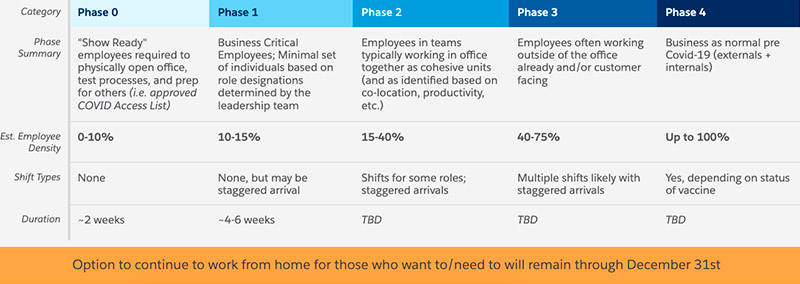
During chaotic circumstances, adopting a phased approach like this can serve as a guide to help provide some structure as you return to the workplace. It can also set expectation and provides a common language for both leadership and employees to understand where the business is in the process.
But we can’t predict the future. You will more than likely need to make adjustments over time. You may even need to skip around phases. For example, if an outbreak occurs while you’re in Phase 4, you might have to return to Phase 0 or 1. Maintain flexibility, and you’ll be on the right track.
Create your own Phase 0 reopening checklist with this free template.
2. Prepare Your Employees
Social distancing in the office goes beyond keeping a 6-foot distance from your co-worker. It involves completely reimagining normal office life. This may include daily wellness checks, mandatory face coverings, and scheduled shifts for each team. You’ll need to walk your employees through all of these changes and more. Below are some tactics that Salesforce is using:
Flexible Work Policies
Just because the company has decided to reopen the office doesn’t mean all of your employees feel comfortable returning. Consider adopting a flexible work policy that allows those who want or need to remain at home to do so. This creates two benefits:
- Fosters a safer environment: Fewer people will be in the building, making it easier to allow for the required physical distances between colleagues.
- Maintains employee satisfaction: Showing flexibility highlights an employer’s ability to empathize and care for its staff. It demonstrates that you’re willing to prioritize the health and wellness of individuals over your need for them to be in the office.
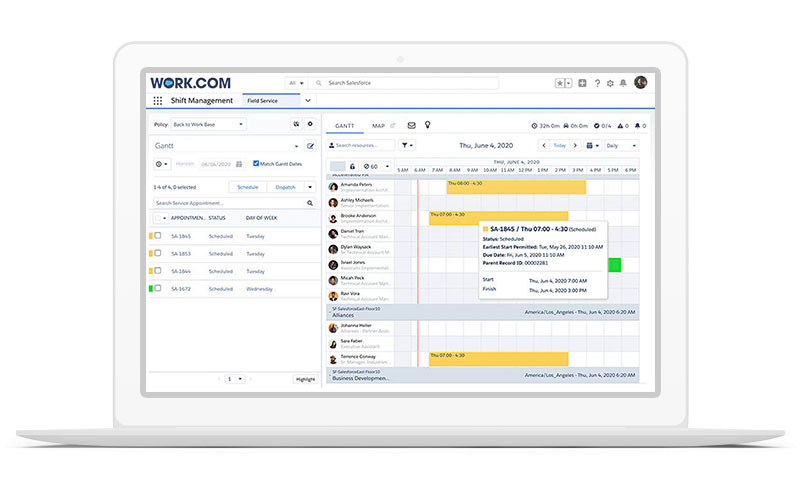
Work Shifts
To ensure that the number of employees who return to the workplace does not exceed the reduced capacity, you may need to split the workforce into groups that work alternating days or weeks and assign staggered arrival times to avoid crowding in lobbies and elevators.
Be careful to put those who perform similar job functions or are on the same team on separate shifts. This can help allow for business continuity should a positive case be reported on one shift and not the other.
Salesforce uses Work.com to plan and manage our shifts. The app helps us determine who is eligible to return to work based on health and safety standards and who would like to return. It also helps us communicate and coordinate those shifts with employees, who receive messages in the app.
Daily Wellness Check-Ins
As part of confirming their shift, Salesforce is asking employees to complete a daily wellness questionnaire before they head into the office to ensure they do not exhibit signs of COVID-19.
Questions might include:
- I have not tested positive for COVID-19 in the past 14 calendar days.
- I have measured my body temperature within the last 3 hours and the reading was lower than 100.4℉ or 38℃.
- I am not experiencing any symptoms consistent with COVID-19, including but not limited to fever, persistent dry cough, chest pain, loss of sense of smell/taste, body aches, and so on.
- I have not had contact in the past 14 days with anyone confirmed or suspected of having COVID-19.
- I have not traveled internationally or traveled outside my state/province in the past 14 days (other than for my regular work commute and daily activities).
Make sure to check local laws before requiring this type of questionnaire.
Face Coverings, Gloves, and Other Protective Equipment
In addition to maintaining social distancing, The Centers for Disease Control and Prevention recommends wearing face coverings. Although a cloth face covering may not protect the wearer, it may keep them from spreading the virus to others. Purchase the appropriate protective equipment for your staff.
Salesforce provides face coverings for everyone to wear in the office, which will be required except for when at a desk or while eating.
Temperature Checks (as local laws allow)
In addition to the self-reported temperatures during daily wellness check-ins, Salesforce has installed kiosks where employees can take their temperature at the office. Our goal is to make these easy to use and accessible for all employees.
Learn how Trailhead can help skill up your team as you return to work.
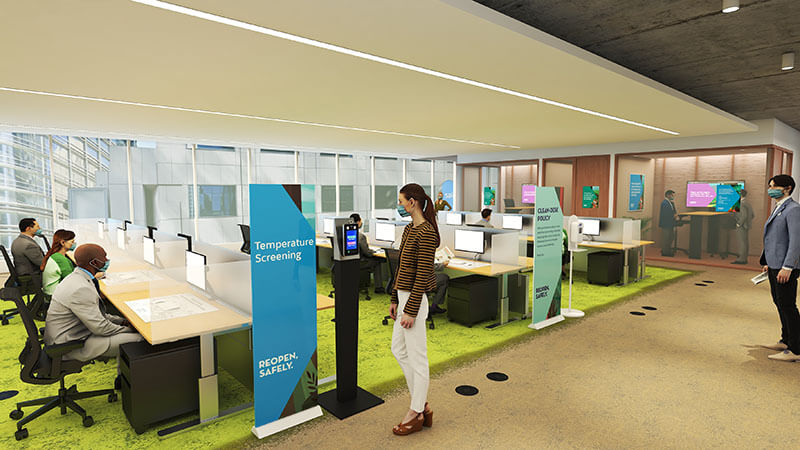
3. Rethink Your Office
The design of your office plays a critical role in keeping your employees safe. Design may include everything from spacing out workstations to adding hand-washing or sanitizing stations. When rethinking your space, pay attention to the following areas:
Workstations
The 6-foot rule should extend to desks and space around them. For Salesforce, this means reducing floor capacity by 40% to 50%, removing chairs and desks, and installing plexi dividers to safeguard workstations.
To make it easier to deep clean, consider eliminating assigned seating and asking all employees to take home their personal items.
Shared Spaces
Again, capacity is the name of the game. Consider keeping it low in shared spaces (for example, kitchens, restrooms, meeting rooms) to maintain distance between employees. We’re encouraging employees not to gather in groups larger than 10 people.
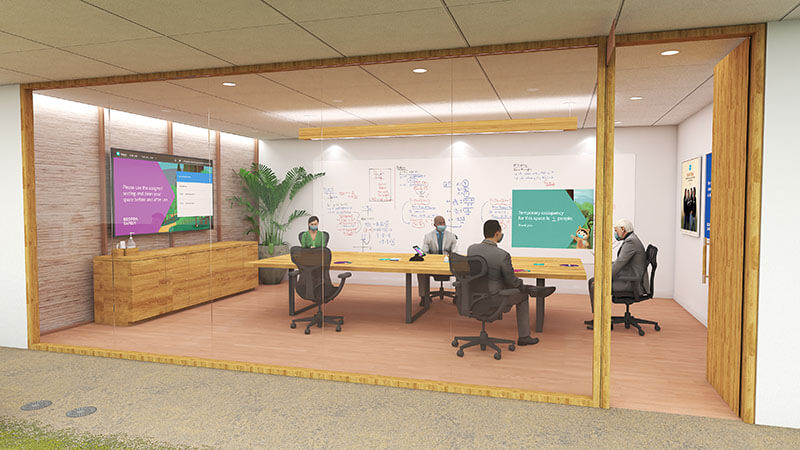
Signage
Visual cues, such as signs and stickers, can serve as friendly reminders for employees to keep their distance and help manage the flow of foot traffic in potential areas of crowding. Below are a few signs we’re using at the Salesforce offices.
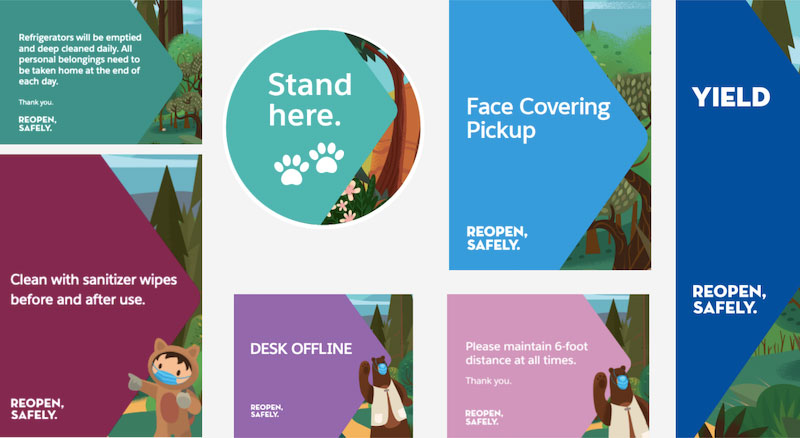
Hand-Washing and Sanitizer Stations
Hand-washing and sanitizing can be your superpower when it comes to preventing the spread of coronavirus. To promote these habits, consider adding hand-washing and sanitizer stations throughout your office.
At Salesforce, we’ve added dispensers on every floor, in every meeting room, and at every reception desk.
Enhanced Cleaning
Ramp up your cleaning routine. Ask cleaning crews to wipe down high-touch areas, such as doorknobs, elevator keypads, and touchscreens, multiple times throughout the day. Twice a week in the evening, implement a more rigorous cleaning.
If someone tests positive for COVID-19, consider hiring a reputable third party to decontaminate your workplace. They will have the expertise that your routine in-house cleaning crew may not. Before committing, review the company’s experience, methodologies, and the products they use to ensure safety.
Elevators
It’s an enclosed space. And if you’re in a tall building, it’s often unavoidable. Welcome to the elevator. Here are the new Salesforce rules of the ride:
- Allow fewer people per elevator to maintain physical distance
- Require staggered employee arrivals to avoid long lines backing up into the lobby
- No talking while inside
Food and Beverage Program
Don’t worry, you can still eat the food that you brought from home. It’s the office-sponsored meals, snacks, and beverages you have to watch out for.
- Catering and food delivery: During the initial phases of reopening, no catering should be allowed for meetings and events. Individual food delivery should be limited to specific floors to minimize visitor access and employee movement. Eventually, in later phases, you can loosen this restriction.
- Snack and beverage program: All snacks and drinks should be individually packaged. Avoid bulk products.
- Kitchen amenities: Switch to compostable and disposable cups, utensils, and plates to avoid contamination. Enforce daily refrigerator cleanings.
HVAC and Filtration Inspection
Assess each building for optimal air circulation to cut back on the spread of the virus. The goal is to bring in as much fresh air as possible. This could take several forms, such as:
- Opening operable windows where safe
- Avoiding air recirculation or filtering recirculated air
- Disabling systems that reduce airflow, including CO2 sensors
- Keeping HVAC systems running 24/7, including restroom exhaust
- Meeting with the landlord of each building to review their air quality plan
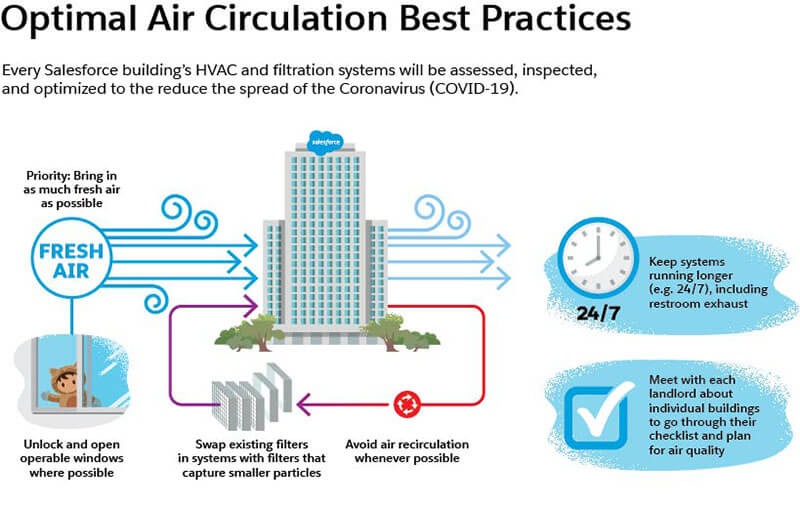
4. Share Your Return-to-Work Plan with Employees
Communicate. Communicate. Communicate. It’s so important, we’re saying it three times. Reopening an office impacts everyone who works inside the building, and each person plays a role in keeping the entire community safe. Maintain active participation with a regular communication cadence. Below is a sample timeline for sharing your return-to-work plan to return to the workplace:
- Two weeks before reopening:
- Announce the date the office will reopen.
- Share the reopening plan in a central place employees have regular access to.
- Offer digital training using Trailhead to ensure employees understand the new workplace setup before they enter the office.
- One week before reopening:
- Hold a town hall with local leadership, health officials, and human resources to review the plan and answer questions. Follow up with an email that includes a summary and a video for anyone who missed the meeting.
- Identify who is qualified (based on the phases you outlined above) and who is interested in returning to work. Tell employees their new shifts and arrival schedules.
- Opening day:
- Send a message before an employee’s shift to welcome them back and include the daily wellness questionnaire.
- Survey employees about how their first day went.
Executive Vice President of Global Real Estate, Salesforce
More Resources

Build a Workforce Action Plan
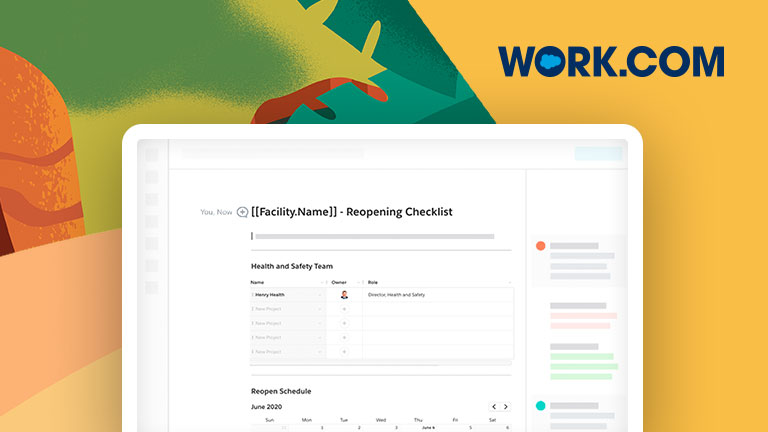
Create a Reopening Checklist
